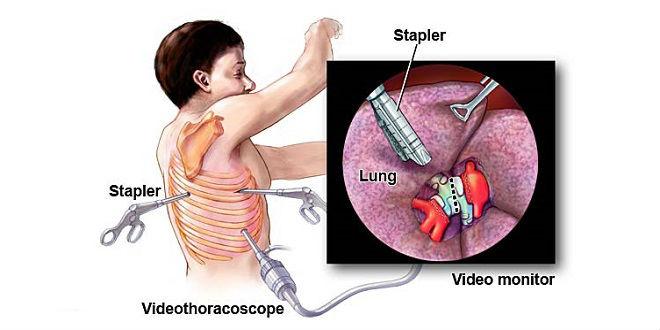Thoracoscopy Doctor in Mumbai
What Is a Thoracoscopy ?
A Thoracoscopy is a procedure to visualize space between Lung and Chest wall
. It involves putting a telescope between two ribs into the chest through a tiny hole.
Why I have been advised to have this test?
- To help find out the cause of fluid collection around your Lung
- To take biopsies.
- For instillation of Drug
- To know cause and site of air leak

What are pre procedure requirements?
Ultrasound ( USG ) or CT scan ( CAT SCAN) will be done to find out about
quantity of fluid, site of entry.
The patient won’t be allowed to eat or drink for 6 hrs prior to the procedure. Please inform the Nurse / Doctor if you are diabetic or on any blood-thinning medications like warfarin.
What Happens during Procedure ?
A sedative drug may be injected into your vein to relax you. Sometimes you will not remember having thoracoscopy because of the sedative. You will be given an injection of local anesthetic into the skin and then into the muscle between your ribs. The doctor will make a small cut in the skin, and then place a hollow tube through this cut into space between the lung and chest wall (pleural space). Sometimes a second cut may be needed.
The doctor will then insert a telescopic instrument through the hollow tube.
The doctor will use this instrument to look around the pleural space and/or obtain pleural biopsies by removing small pieces of the lining of the pleural space. This may cause some pain.
If required the doctor may gently spray sterile talc powder into the pleural space. This powder is used to create a sticking reaction between the lung and chest wall which may help prevent future fluid or air building up in the pleural space. At the end of the procedure, you will have a chest tube put into the pleural space through the same incision.
Risk of Thoracoscopy
Common risks and complications (more than 5%) include:
- Chest pain: The nerves between the ribs are bruised after the procedure, which can cause some persistent pain. This may be controlled with paracetamol.
- Fever: This happens if you have had talc sprayed. The fever goes away in a few days.
- Increased risk in obese people of wound infection, chest infection, heart and lung complications, and thrombosis.
Uncommon risks and complications (1- 5%) include:
- Air leak from lung. A small hole develops in the lung. This means the chest tube has to stay in longer.
- Subcutaneous emphysema :
Rare risks and complications (less than 1%) include:
- Infection: A small chest tube will be put into the pleural space to drain out the infection. This will need antibiotics.
- Bleeding: This can happen after biopsies. Usually, it is minor and settles quickly. Bleeding is more common if you have been taking blood-thinning drugs such as Warfarin, Aspirin, Clopidogrel (Plavix or Iscover), or Dipyridamole (Persantin or Asasantin).
- Heart problems: A brief minor strain may be put on the heart. This can cause the abnormal beating of the heart, fluid to accumulate in the lungs, a heart attack or the heart may stop beating.
- Low oxygen levels. You will be given oxygen.
- Adult Respiratory Distress Syndrome: This can happen after talc is sprayed in the pleural space. The talc powder may cause damage to both lungs which may cause severe breathing difficulty. This may start days after the procedure.
- Death as a result of this procedure is rare.

Dr. Parthiv Shah
Best Pulmonologist in Mumbai
